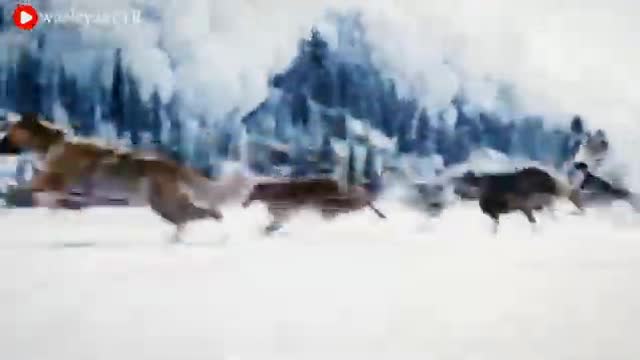Premium Only Content

Brave Dogs'🐕 Helping video🔥 //Dog lovers🐕//
The domestic dog (Canis familiaris or Canis lupus familiaris)[4] is a domesticated descendant of the wolf. The dog derived from an ancient, extinct wolf,[5][6] with the modern grey wolf being the dog's nearest living relative.[7] The dog was the first species to be domesticated,[8][7] by hunter-gatherers over 15,000 years ago,[6] before the development of agriculture.[1] Their long association with humans has led dogs to be uniquely adapted to human behavior,[9] leading to a large number of domestic individuals[10] and the ability to thrive on a starch-rich diet that would be inadequate for other canids.[11]
Domestic dogs
Temporal range: At least 14,200 years ago – present[1]









Conservation status
Domesticated
Scientific classificationKingdom:AnimaliaPhylum:ChordataClass:MammaliaOrder:CarnivoraFamily:CanidaeSubfamily:CaninaeTribe:CaniniSubtribe:CaninaGenus:CanisSpecies:
C. lupus
Subspecies:
C. l. familiaris
Trinomial nameCanis lupus familiaris
Linnaeus, 1758[2]
Synonyms
[3]
C. aegyptius Linnaeus, 1758
C. alco C. E. H. Smith, 1839,
C. americanus Gmelin, 1792
C. anglicus Gmelin, 1792
C. antarcticus Gmelin, 1792
C. aprinus Gmelin, 1792
C. aquaticus Linnaeus, 1758
C. aquatilis Gmelin, 1792
C. avicularis Gmelin, 1792
C. borealis C. E. H. Smith, 1839
C. brevipilis Gmelin, 1792
C. cursorius Gmelin, 1792
C. domesticus Linnaeus, 1758
C. extrarius Gmelin, 1792
C. ferus C. E. H. Smith, 1839
C. fricator Gmelin, 1792
C. fricatrix Linnaeus, 1758
C. fuillus Gmelin, 1792
C. gallicus Gmelin, 1792
C. glaucus C. E. H. Smith, 1839
C. graius Linnaeus, 1758
C. grajus Gmelin, 1792
C. hagenbecki Krumbiegel, 1950
C. haitensis C. E. H. Smith, 1839
C. hibernicus Gmelin, 1792
C. hirsutus Gmelin, 1792
C. hybridus Gmelin, 1792
C. islandicus Gmelin, 1792
C. italicus Gmelin, 1792
C. laniarius Gmelin, 1792
C. leoninus Gmelin, 1792
C. leporarius C. E. H. Smith, 1839
C. major Gmelin, 1792
C. mastinus Linnaeus, 1758
C. melitacus Gmelin, 1792
C. melitaeus Linnaeus, 1758
C. minor Gmelin, 1792
C. molossus Gmelin, 1792
C. mustelinus Linnaeus, 1758
C. obesus Gmelin, 1792
C. orientalis Gmelin, 1792
C. pacificus C. E. H. Smith, 1839
C. plancus Gmelin, 1792
C. pomeranus Gmelin, 1792
C. sagaces C. E. H. Smith, 1839
C. sanguinarius C. E. H. Smith, 1839
C. sagax Linnaeus, 1758
C. scoticus Gmelin, 1792
C. sibiricus Gmelin, 1792
C. suillus C. E. H. Smith, 1839
C. terraenovae C. E. H. Smith, 1839
C. terrarius C. E. H. Smith, 1839
C. turcicus Gmelin, 1792
C. urcani C. E. H. Smith, 1839
C. variegatus Gmelin, 1792
C. venaticus Gmelin, 1792
C. vertegus Gmelin, 1792
The dog has been selectively bred over millennia for various behaviors, sensory capabilities, and physical attributes.[12] Dogs are sub classified into breeds, which vary widely in shape, size, and color.[13] They perform many roles for humans, such as hunting, herding, pulling loads, protection, assisting police and the military, companionship, therapy, and aiding disabled people. This influence on human society has given them the sobriquet of "man's best friend."
-
 0:58
0:58
akosnemeth
3 years agodog helping funny video
34 -
 LIVE
LIVE
The StoneZONE with Roger Stone
2 hours agoAre We Heading For World War III? General Michael Flynn Joins The StoneZONE w/ Roger Stone
1,219 watching -
 LIVE
LIVE
We Like Shooting
12 hours agoDouble Tap 384 (Gun Podcast)
127 watching -
 LIVE
LIVE
Tundra Gaming Live
4 hours agoThe Worlds Okayest War Thunder Stream
310 watching -
 1:20:47
1:20:47
Donald Trump Jr.
6 hours agoThe MAGA Cultural Shift, Plus UFC at MSG & Interview with Newt Gingrich | TRIGGERED Ep.192
103K90 -
 45:18
45:18
Kimberly Guilfoyle
6 hours agoBreaking News on Latest Cabinet Picks, Media Spins in Circles,Live with Tim Hentschel & Alex Epstein | Ep. 175
108K27 -
 1:45:00
1:45:00
Redacted News
5 hours agoBREAKING! TRUMP TO DECLARE NATIONAL EMERGENCY DECLARATION DEPLOY MILITARY TO SOUTHERN BORDER
161K402 -
 52:28
52:28
Candace Show Podcast
5 hours agoBeyonce's Mommy Attacks Me On Instagram | Candace Ep 105
114K299 -
 45:26
45:26
Sarah Westall
3 hours agoPentagon, High Level Gov Officials & their Foot Soldiers are Planning an Insurrection: Millie Weaver
3.63K3 -
 1:18:31
1:18:31
Awaken With JP
7 hours agoAre We Going to Nuclear War? - LIES Ep 66
107K103